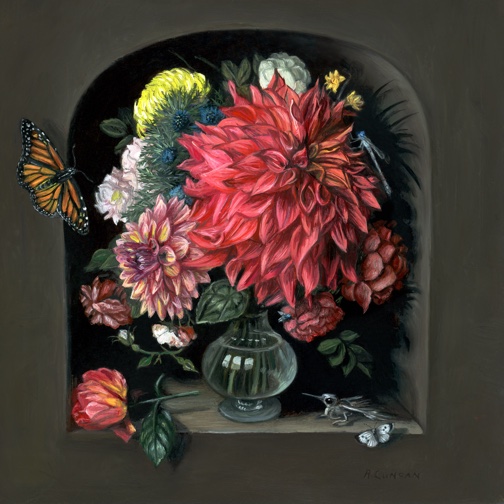Spring has officially sprung and i hope that my newest Monthly Miniature floral painting reflects that. You may have noticed that my first four paintings in this series all have a slightly different feel (see them all on the Monthly Miniature page). Part of the change is the increase in plants and insects awakening to populate each months painting, and for April, I wanted to pack the painting full of new lush blooms. I have included seven types of plants (some in different colors), three insects and the nest of a Dark-Eyed Junco that my husband found in our yard. You can find a complete list at the end of this post.
In addition to changing the subjects in my paintings, I’m also changing how they are composed. For each of my twelve miniatures this year, I’m studying a different master of still life paintings from Northern Europe (1600-1800). I’ve long admired paintings from this era and this series is giving me the opportunity to luxuriate in the detailed little worlds created by so many different artists. See the inspiration behind all of the “In Season” miniatures in previous posts.
Abundance of blooms: Gerard Van Spaendonck

Flower still Life, oil on canvas, 22.5″ x 16″
Gerard Van Spaendonck (1746 – 1822) was an influential Dutch painter, who settled in Paris early in his career. He is known for his fabulously dense oil paintings filled with a wide assortment of flowers and a variety of other living creatures. Gerard was a master at creating an explosion of color and texture.
I’m generally drawn to simple compositions, but I wanted to go in a different direction with this painting and he was the perfect muse. I’ve been excited to change the subjects of each Miniature and highlight what is currently in season. It’s been an interesting challenge to also think of creating a mood that is reflecting the sparsity or abundance of things available as well. I have each month sketched out for the rest of the year already!
I carefully choose each of my blooms, but heavily referenced his composition from the painting, “Flower Still Life”. My plants came from a variety of places; some I found online, others were purchased, and some I picked from my garden which is starting to explode! The Seattle Growers Market is a great resource, with public hours on Fridays, 10 am – noon. I took photos and mixed everything together on the computer for the composition (Pixelmator for Mac). I posed as much as I could in a Frankenstein taped up heap to reference from life but used my digital mock up as a primary reference for plants. The birds nest with egg and caterpillar were painted solely from life (my three year old son got caterpillars for his birthday!)
What’s in my painting?
Birds and Insects:
Bumblebee
Housefly
Painted Lady Caterpillar
Dark-Eyed Oregon Junco nest and egg
Plants:
Anemones – white and yellow
Euphoria
Grape Hyacinths
Kale
Ranunculus – red, white and pink
Salal (leaves)
Tulips – rainbow parrot, flaming white parrot, Absalom, mint green parrots




























